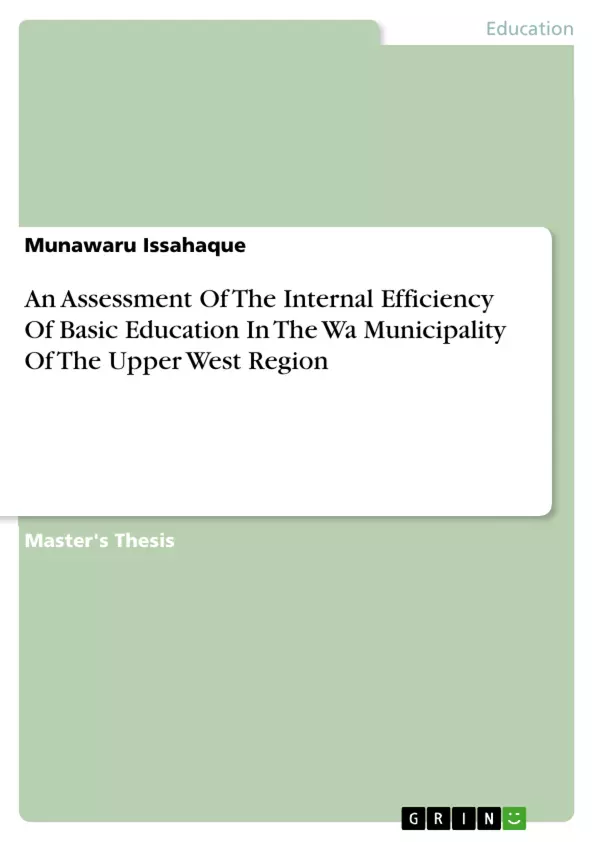The purpose of the study was to determine the internal efficiency of basic education in the Wa Municipality of the Upper West Region. The objectives of the study were to find: the enrolment ratio and growth rate, the repetition and dropout rate, the pupil-teacher ratio as compared to the national norm, as well as to determine the completion rate of pupils in public basic schools in the Wa Municipality.
The apparent cohort method was used to determine the internal efficiency of basic education in the Wa municipality based on the foregoing indicators of internal efficiency. A simple random sampling technique was used to select 18 primary schools and 18 junior high schools giving a sample size of 36. Questionnaires were used to collect the data after pilot testing to establish Cronbach’s Alpha Co-efficient of reliability which was 97.
Data were collected from such school records as enrolment, dropout, promotion, transfers and death records.
The data collection instrument was questionnaires. It was found that repetition and drop-out rates were generally low in the Municipality.Additionally , the completion rate was also low which requires further investigation. The researcher recommends that parents, teachers and Educational Authorities should collaborate to increase the enrolment of the girl-child to the level of boys by improving on the teaching learning conditions in order to increase the completion rate to at least 60%.
Table of Contents
- CHAPTER ONE
- INTRODUCTION
- Background to the Study
- Statement of the Problem
- Purpose of the Study
- Research Questions
- Significance of the Study
- Delimitation of the Study
- Limitation
- Definition of Terms
- Organization of the Thesis
- CHAPTER TWO
- REVIEW OF RELATED LITERATURE
- School Efficiency
- The Concept of Efficiency
- School Wastage
- Indicators of Coverage and Internal Efficiency
- The Concept of Internal Efficiency
- School Enrolment
- Gross Enrolment
- Net Enrolment
- Repetition and Dropout
- Pupil - Teacher Ratio
- Teacher Population
- Primary School Completion Rate
- Teacher Quantity and Quality
- Summary of Chapter Two
- CHAPTER THREE
- METHODOLOGY
- The Research Design
- The Population
- Sample and Sampling Procedure
- The Research Instruments
- Pilot Test
- Data Collection Procedure
- Data Analysis
- CHAPTER FOUR
- RESULTS AND DISCUSSION
- CHAPTER FIVE
- SUMMARY, CONCLUSIONS AND RECOMMENDATIONS
- Summary
- Summary of Findings
- Conclusions
- Recommendations
- Suggestion for Further Research
Objectives and Key Themes
This research aims to determine the internal efficiency of basic education in the Wa Municipality of the Upper West Region. It seeks to evaluate key indicators such as enrolment ratio and growth rate, repetition and dropout rate, pupil-teacher ratio, and the completion rate of pupils in public basic schools within the municipality.
- Internal Efficiency of Basic Education
- Enrolment and Growth Rate
- Repetition and Dropout Rates
- Pupil-Teacher Ratio
- Completion Rate
Chapter Summaries
Chapter One provides an introduction to the study, outlining the background, statement of the problem, purpose, research questions, significance, delimitation, limitations, definition of terms, and organization of the thesis. Chapter Two delves into the review of related literature, focusing on the concept of efficiency, school wastage, indicators of coverage and internal efficiency, the concept of internal efficiency, school enrolment, gross enrolment, net enrolment, repetition and dropout, pupil-teacher ratio, teacher population, primary school completion rate, teacher quantity and quality, and concluding with a summary of the chapter. Chapter Three presents the research methodology, including the research design, population, sample and sampling procedure, research instruments, pilot test, data collection procedure, and data analysis.
Keywords
The main keywords and focus topics of this thesis include internal efficiency, basic education, enrolment, repetition, dropout, pupil-teacher ratio, completion rate, Wa Municipality, Upper West Region, Ghana.
- Citation du texte
- Dr. Munawaru Issahaque (Auteur), 2010, An Assessment Of The Internal Efficiency Of Basic Education In The Wa Municipality Of The Upper West Region, Munich, GRIN Verlag, https://www.grin.com/document/461294



